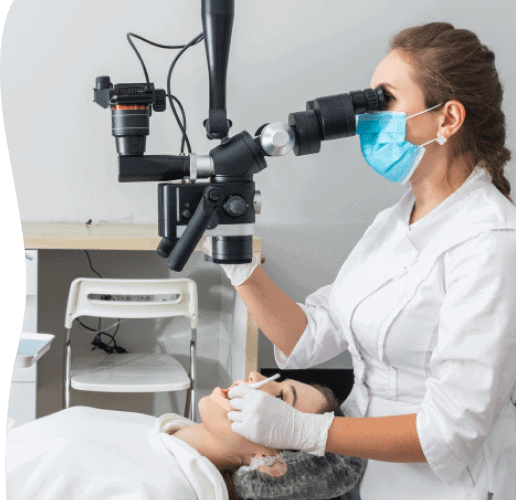Are you considering getting Invisalign treatment to straighten your teeth? Having a virtually invisible alternative to traditional braces can be hugely appealing. However, the first question many people have is: Is there pain from Invisalign?
In this blog post, we will discuss the ins and outs of Invisalign treatment, also called invisible braces. Let’s see if there’s any truth to Invisalign pain and what to expect regarding Invisalign discomfort.
Read on to learn more about whether Invisalign might be right for you. Discover if it’s worth considering as a viable option for straightening teeth.

What Occurs During an Invisalign Treatment Process?
Invisalign treatments provide an effective and convenient way to straighten crooked teeth. In contrast to traditional braces, Invisalign treatment does not involve uncomfortable metal wires and brackets visible to everyone.
Invisalign treatment consists of a series of dental appliances called clear aligners. These are custom-made specifically for your teeth and mouth. In each stage of the treatment process, patients will wear new aligners designed to fit snugly over their teeth. These aligners will exert slight pressure on teeth to cause tooth movements. The aligners gently move your teeth into their proper positions over time.
Over the course of treatment, you’ll need to schedule appointments with your Invisalign provider once every 6-8 weeks so they may:
- Review your progress
- Give you new sets of aligners
- Check that all is going as planned along with your Invisalign treatment plan
In addition to regular checkups from your Invisalign provider, you will also wear the aligner trays day and night. You need to wear them for at least 20-22 hours per day for Invisalign treatments to work faster and achieve optimal results.
With just a few simple steps, most adults can complete their Invisalign treatment process in about 12 months!
Can Invisalign Cause Pain?
Invisalign has made it easier to achieve the straight and beautiful smile of your dreams. However, many people wonder if there’s a possibility of Invisalign pain.
In most cases, the answer is no; Invisalign rarely causes prolonged pain. However, it can cause slight discomfort while changing your bite or jaw alignment.
When starting treatment, wearing dental aligners for extended periods may cause sensitive teeth. The aligners can irritate your gums and cause gum pain or mouth sores as you get used to them. Take regular breaks throughout the process.
In some rare cases, more serious pain can occur. This may be due to an underlying oral condition being aggravated by Invisalign. If this happens, speak with a knowledgeable dental professional about your options.
The upshot is that Invisalign is typically very comfortable for users. It doesn’t require much effort beyond following the care instructions from your dental provider.
How Long Will Your Teeth Hurt After Getting Invisalign?
Pain from Invisalign is still one of the common worries patients have when considering this teeth-straightening option. Invisalign pain can vary greatly from person to person. This can be due to several factors, including pain threshold. This makes it hard to provide an exact answer to the question of how long teeth will hurt after getting Invisalign.
Initial discomfort is expected during the first couple of weeks of starting treatment. During this time, you’ll have sore teeth as your mouth adjusts to wearing your dental aligners. You may feel mild discomfort or temporary pain as your teeth start shifting position. After the initial pain subsides, you’ll likely experience discomfort as your Invisalign treatment progresses. This is experienced whenever you change to a new aligner. However, pain should only be mild.
The right thing to do is to follow your orthodontist’s instructions and use painkillers if needed.
Get Outstanding Dental Care with Us Today
At The Smile Space, we believe that comprehensive dental care should be accessible to everyone. Our experienced team is dedicated to providing the highest standard of care, using the latest technology and techniques. If you're looking for a dentist in Sutherland, book an appointment at The Smile Space today!

How Can I Relieve Pain From Invisalign?
Invisalign pain can be a common side effect experienced by patients. Luckily, pain relief is just steps away!
Here are six tips on how to relieve pain associated with Invisalign:
- Take over-the-counter pain medication to manage the pain.
- Apply an ice pack to the area. You may also drink cold water or keep ice cubes around the area. However, do not bite on the ice cubes.
- Rinse your mouth with a saltwater solution
- Massage the affected area lightly
- Avoid hard and chewy foods, and stick to softer foods and liquids.
- Try using special wax that can be purchased from your dentist.
Don’t let the pain from Invisalign stop you from achieving your dream smile. Follow these tips, and you’ll be free from Invisalign discomfort in no time!

How Can I Prevent Invisalign Pain?
When considering pain prevention for Invisalign treatment, there are many things you can do to maintain comfort.
- Check your Invisalign every morning and night. Make sure that each tray is comfortable and properly fitted. Also, check your aligners for any sharp and rough edges.
- Refrain from eating sticky, chewy or crunchy foods while undergoing treatment. Despite removing your aligners, these foods could still cause dental pain in your sensitive teeth. Instead, choose soft foods.
- Use wax strips to cover any sharp edges after switching trays.
- Brush and floss your teeth daily to remove food particles and maintain good oral hygiene. This can also help reduce sensitivity during treatment.
- Regularly keep up with checkups so any pain or discomfort from the aligners can be addressed immediately.
- Wear the aligners and change them as directed by your dentist or orthodontist. Change your aligners before bed to minimise pain.
Following these tips should help minimise negative experiences with pain during Invisalign treatment.
Should I Still Choose to Have Invisalign Despite the Pain?
Invisalign is an excellent choice for those looking to have straighter teeth. However, with any orthodontic treatment, there will be associated with it.
The pain associated with Invisalign is generally mild and localised. This means it will have minimal to no impact on your daily activities.
Despite the potential pain, having Invisalign is a great decision because of its many benefits. Ultimately, the joy of having straight teeth without the discomfort of traditional braces tends to outweigh any hurt caused by adjustments from time to time, so don’t let the fear of pain stop you from getting the beautiful smile you want.
Have a conversation with your dentist or orthodontist before you begin your Invisalign journey. This is so they can guide you on how best to manage discomfort during the process.
Final Thoughts
In general, Invisalign pain can range from mild to moderate discomfort. Most Invisalign patients describe their experience as uncomfortable but tolerable.
Mild Invisalign discomfort can come in the way of aching teeth after the aligners are replaced or tightness due to the pressure exerted by aligners as they push your teeth.
With that being said, it’s important to remember that pain tolerance is different for everybody and each Invisalign journey is unique.
If you’re considering Invisalign, The Smile Space is here to help answer any questions about the treatment process. We believe that straighter teeth lead to happier lives, and we want to help you start your smile journey.
Please book an appointment through our website or by calling us today!
Frequently Asked Questions
What are the benefits of Invisalign treatment?
Invisalign treatment is becoming increasingly popular because of its numerous benefits, which include the following:
- Invisalign eliminates the need for metal brackets, wires, and adhesives. This makes it much more comfortable for patients than traditional metal braces since there are no brackets or wires to irritate their gums and mouth.
- Because the aligners are transparent, they are nearly invisible when worn. This makes the process less intimidating and socially awkward compared to old-fashioned braces.
- It offers flexibility in scheduling routine checkups every 6-8 weeks during treatment cycles.
- Invisalign allows you to eat whatever you want without having to worry about damaging your braces like with traditional braces.
- Due to modern technology, your entire Invisalign treatment plan will be mapped out beforehand so that you know exactly how long it will take to achieve results.
- Unlike traditional orthodontics, which can take up to two years for full completion, Invisalign’s average treatment time is 8-14 months, depending on how severe one’s case is.
If you’re looking for a convenient and effective solution for your smile makeover needs, then Invisalign is worth considering.
How should I clean my Invisalign trays?
Cleaning your Invisalign trays is essential to keeping them in good condition and preventing bacteria buildup. To keep your trays clean, we recommend the following:
- Brush each tray with a soft-bristled toothbrush and lukewarm water before putting it back in your mouth. Avoid hot or warm water as these can cause warping of the plastic aligner.
- Brush your teeth after removing the trays and floss, or use a water flosser.
- Rinse the trays in lukewarm water after every use.
- Avoid getting any harsh cleaner on the trays since it can damage them and make them less effective. For extra cleanliness, you may want to consider soaking your trays in a solution of lukewarm water and a drop of antibacterial dish soap for up to 30 minutes.
- Dry the trays with a soft cloth when you’re done cleaning them.
- Store your Invisalign trays away from heat, direct sunlight, and moisture.
Contact your orthodontist if you have any questions about cleaning your Invisalign trays. They can provide you with the best advice and tips for cleaning and maintaining them. With proper care, you can enjoy a straight and attractive smile with your Invisalign trays!
Can I use my health funds for my Invisalign treatment?
Yes, you should be able to use your health funds for Invisalign treatment.
Depending on your coverage and the provider, your health fund may cover some or all of the costs associated with Invisalign.
In some cases, you may be able to use your health funds for part of the cost and then pay for the rest in monthly instalments.
Check with your health fund to determine if you’re eligible for coverage. Your orthodontist may also be able to provide more information about funding options available for Invisalign treatment. It’s important to understand all of your options before beginning Invisible aligner treatment.
Can all dentists provide Invisalign treatment?
The short answer to this question is no.
While all dentists are familiar with the fundamentals of dentistry, Invisalign treatment is a more specialised type of dental care that not every dentist is trained to provide.
To offer these services, dentists must attend specialised training presented by Invisalign. Certification programs and continuing education courses are available so that dentists can stay on top of the latest developments in digital dentistry and modern braces.







